Continued from the previous page.
ALL ABOARD!
We got on a Kenai Fjords Tours shuttle bus that picked us up at the
Seward Military Resort at 10:30 AM. It was still mostly overcast and in the
upper 40s or low 50s then, not a real promising sign. We saw more and
more sun as the day wore on.
We checked in at the Kenai Fjords Tour office at the small boat harbor, got our
boarding passes, and walked down the pier to wait for about 15 minutes
to board. Our captain told us that our catamaran had 113 passengers
today; I counted at least five crew members.
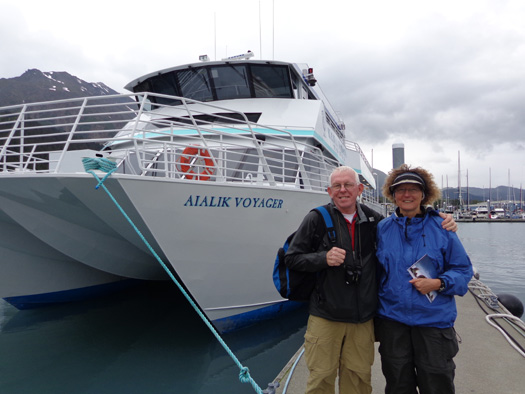
This is the catamaran we rode. Our seatmates took this
picture of us at the end of the trip.
We left the dock about 11:15. A second catamaran left a few minutes
after us with 126 people. The boats each hold about 150 people max.
The company had enough demand today to run two boats instead of just one
during our time slot. They are wise to run more catamarans when the
weather clears up, as it did today.
We were about the 20th-21st people on board so we
had a great choice of seats. We chose a table on the "ground" floor so
we didn’t have to go up and down the stairs to use the bathroom, get
coffee and tea, etc. In addition, there are outdoor decks on both sides,
front, and back on this level.
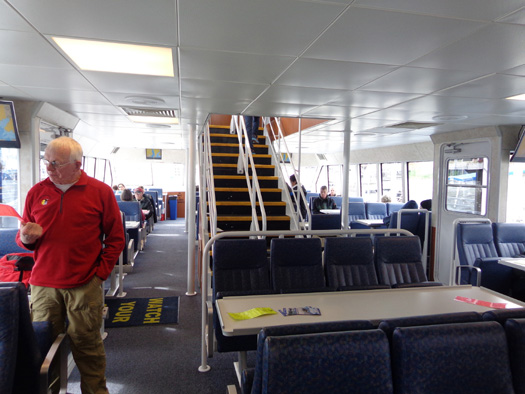
Jim stands by our booth next to the windows on the
left.
Most folks rushed to the top deck when they boarded.
I don’t think that the views were any better up there either inside or outside.
The only outdoor deck was in the back (next photo). I went up once during the
trip to see if I was missing anything -- nope. I could see plenty
from the lower deck, both inside and out.
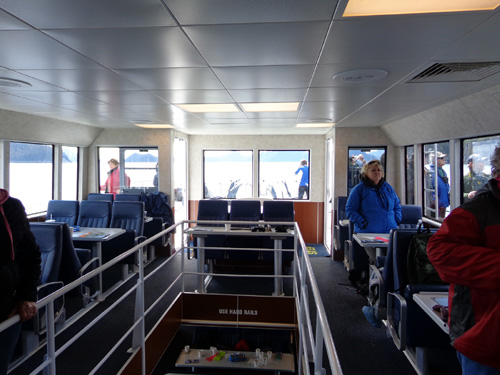
Seating on the upper deck, looking toward the back
of the catamaran
Jim went up to talk with the captain when he wasn't real busy:
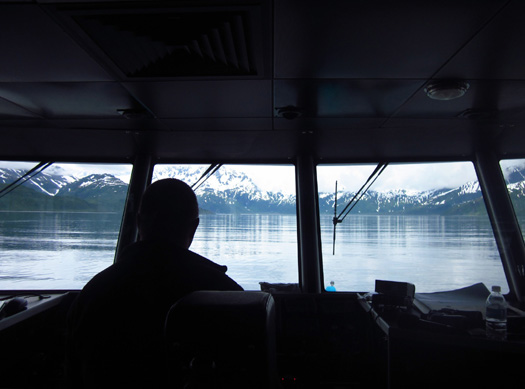
I was happy with our comfortable padded seats next to a window on the port side. We were at
a table for six. A nice retired couple asked if they could sit with us.
That turned out well – Kent and Shari are full-time RVers who used to
live in Minnesota. Like us, this is their first trip to Alaska. We had a
good time sharing information about where we have all been and what
we've done so far in Alaska.
We've gotten lots of good suggestions by talking with other travelers
we've met in Alasaka. We might cross paths with this couple again in the
coming weeks, as our tentative itineraries sometimes coincide.
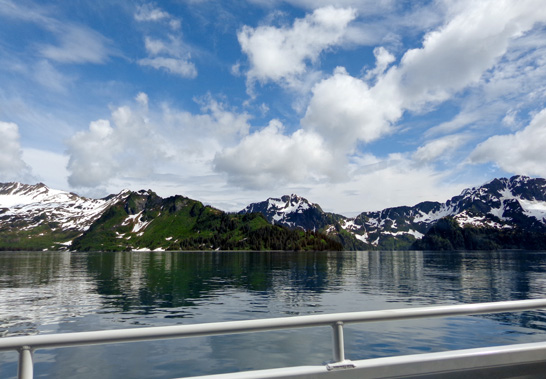
We found more sunshine the farther we got out of
Resurrection Bay; this is the Aialik Glacier fjord.
Jim and I both spent quite a bit of time outside on the way to Aialik
Glacier, even when the boat was cruising fairly fast.
It was cold but I was so fascinated with the passing scenery that I
stayed out as much as I could stand. Sometimes I stood in the doorway
out of the wind but mostly I was on one side or the other or right out
front in the wind:
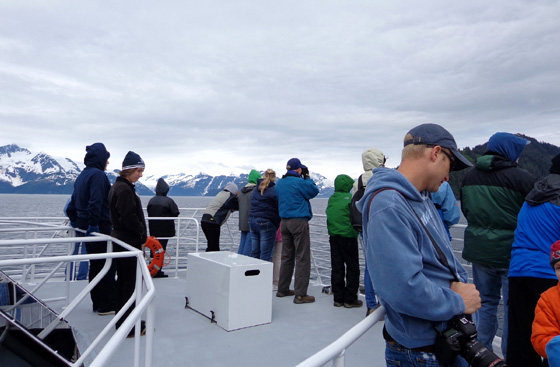
Going outbound to Aialik more people were outside while the catamaran
was moving forward. We were all fresh and excited about the new things
we were seeing.
On the way back to port from Aialik most folks stayed inside unless Ryan
stopped to point something out and they got up to take pictures. Even Jim and I got tired after four or
five hours and sat down much more on the return trip. We were glad we
didn't do an eight- or nine-hour trip. Six was enough.
With fewer people outside when we were port-bound it was easier for me
to stand at the rail and take photos without having to politely
jostle for space:
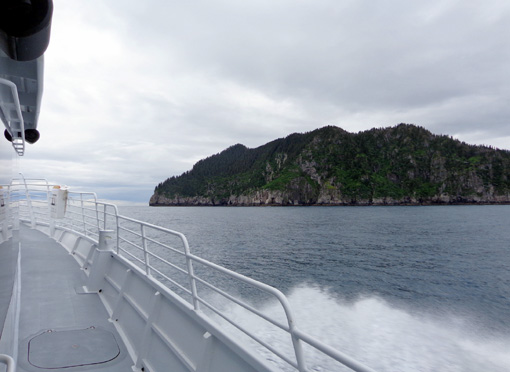
Had this side to myself
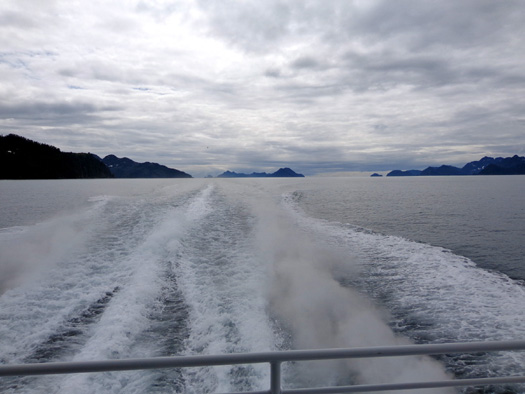
View from the back railing
We were very pleased with all aspects of our tour.
The staff was very accommodating and the captain, Ryan, did a great job
narrating. Some of the boat tours have national park rangers on board to
narrate. I can't imagine any of them could do any better job of providing
interesting information than Ryan did.
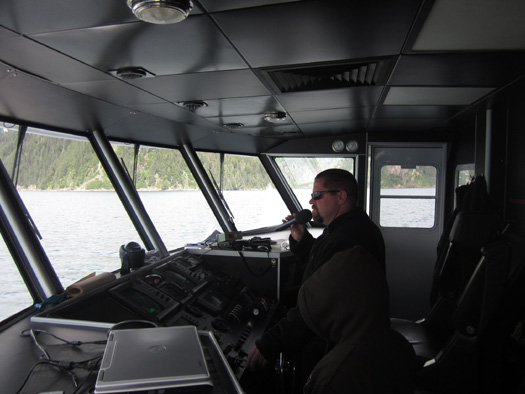
I missed about half of the information he gave us about the terrain,
history, wildlife, etc. because I was outside in the wind quite a bit
and couldn’t hear the speakers. When we were going slowly or stopped we
could hear just fine when we were outside.
The volume inside was even better but I was too hyper to sit still for
long -- I was in a spectacular place and I didn't want to miss a
thing!
Ryan told us exactly where to see humpback whales, sea otters, Stellar
sea lions, puffins, a mountain goat, and other marine animals. We didn’t see any porpoise,
harbor seals, or orcas. He stopped more than a dozen times so we could watch and
photograph the critters.
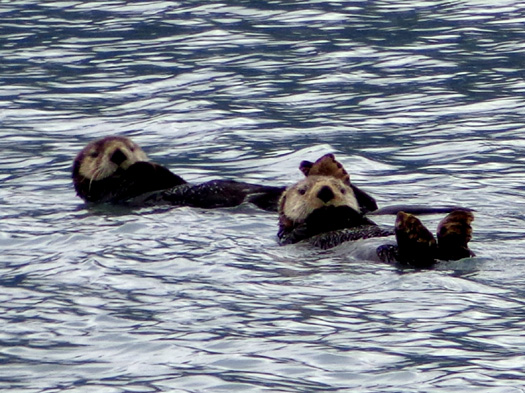
Sea otters look so cute and cuddly floating on
their backs. I think they like to pose for tour boats!
These guys are bigger than they look; adult otters
weigh 75-100 pounds.
AIALIK GLACIER
The captain also stopped for about 25 minutes in front of the
huge Aialik (EYE-a-lick) Glacier at the turnaround point so we could listen to the
glacier make grinding and cracking sounds and see it do some small calving. That was “cool” in
all respects.
Aialik Glacier flows
down about four miles from the massive Harding Icefield, even farther
than Exit Glacier.
Aialik is a tidal
glacier, which means it terminates in a body of water with tides (as
opposed to ending in a lake or lagoon, or being suspended in a cirque or
on a cliff). According to our captain its face ranges from
200-300 feet high above the water and more than half a mile wide:
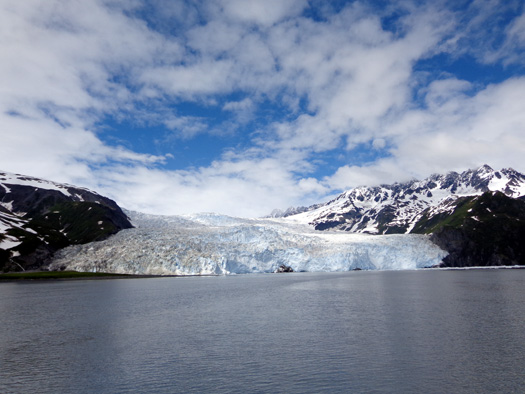
It's big! So are some
of the hunks of ice that break off of it and become icebergs floating in the
bay.
Jim's holding one of
the smaller pieces of ice that came from the glacier. A crew member fished it
out of the water for passengers to inspect:
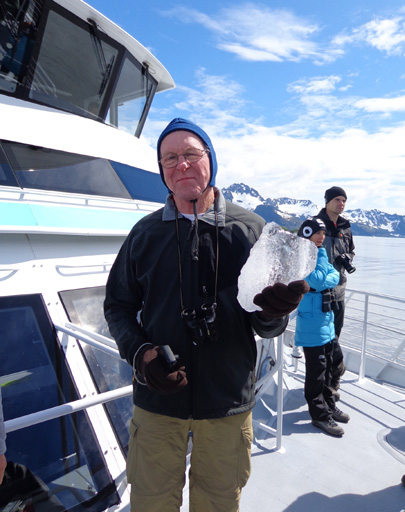
Yes, it's cold back here in the bay with all the
ice floating around!
Unfortunately, we weren't able to capture any of the calving action with our
cameras but we could see and hear ice breaking off and falling into the water.
We could also hear the glacier creaking and groaning from hundreds of
yards away. Glaciers often move several feet a day, scraping the rocks
beneath them. Although we couldn't see the glacier advance we could hear
the sounds it made as everyone on the boat listened quietly.
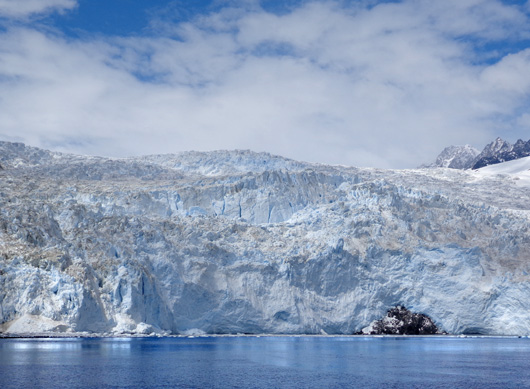
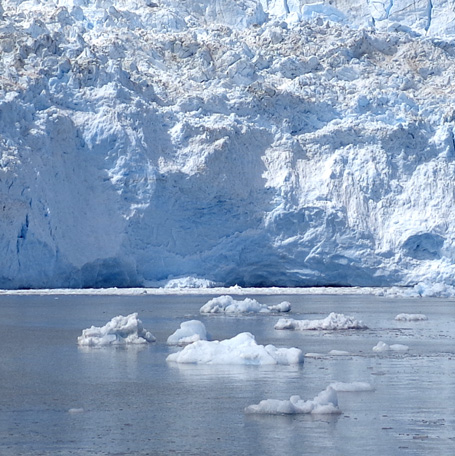
I found a USGS
website that describes the advances and retreats of various glaciers
in Alaska over the past century or longer. It appears that Aialik has
retreated (shrunk) less than some of the others. That's one of the
reasons it's still such an impressive sight to behold.
The next two photos show the left and right sides of this large glacier:
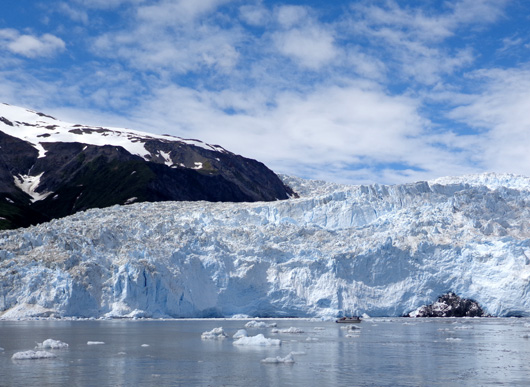
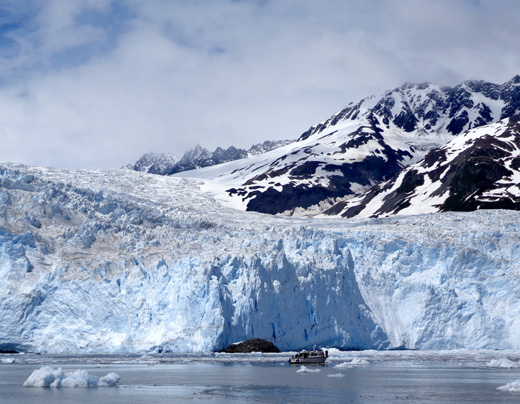
I
t's
a good thing no large blocks of ice broke off while we were there because
the boat you can see in both of those pictures was
taking a huge risk by being so close to the face of the glacier. It is
not a boat from either of two companies mentioned here.
Not only were those folks in danger if a large falling chunk of ice caused a
wave that could knock them over, the icebergs floating in the water near
them are also unstable and could flip over unexpectedly;
most of their mass is submerged and barely visible.
This is a great
explanation of the phenomenon, and the
reason Ryan kept our catamaran a good distance from the glacier and
the large icebergs near it.
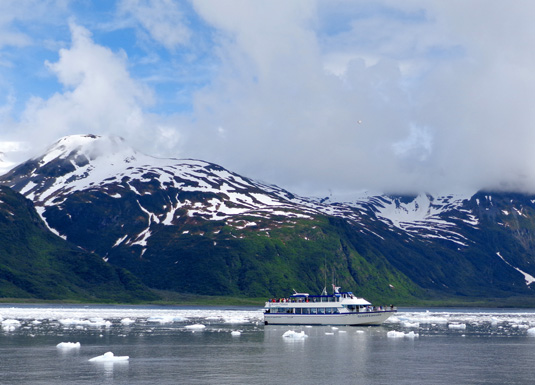
The boat in the picture directly above is the other Kenai Fjords Tours
catamaran that left when we did. Although it got into more floating ice
than our boat did, it did not get any closer than ours to the face of Aialik.
SCENIC "DETOUR" ON THE RETURN TRIP
After we watched Aialik Glacier for about 25 minutes the captain continued around the other
side of the island in front of it, making a large U at the end of
the bay, and steered the catamaran closer
to the other side of the fjord as we headed back out to sea.
Several of the photos I've already shown are from this area. Here's one
more:
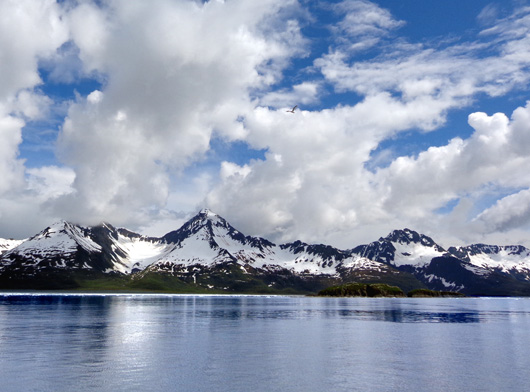
A vision in blue, white, and green
It was so beautiful there, I didn't want to leave. Our captain had much
more to show us on our way back to Seward, however.
We passed by Three-Hole Point again before rounding Aialik Cape and
heading out into more open water on our way back north:
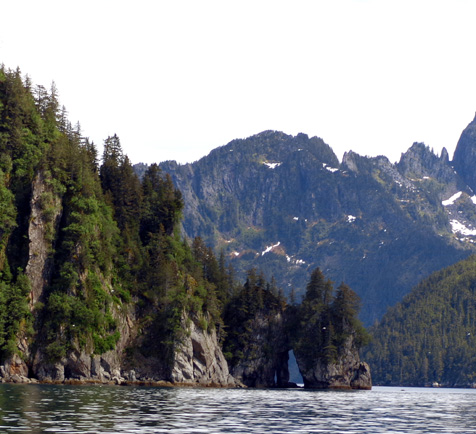
Around Aialik Cape and past Pilot Rock,
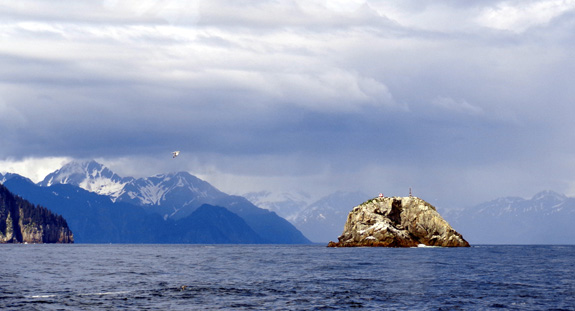
back out into the open Gulf of Alaska waters, we saw
more humpback whales blowing, breaching, and showing their flukes
(tails):
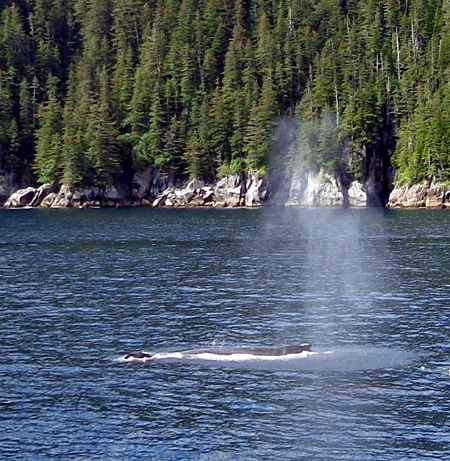
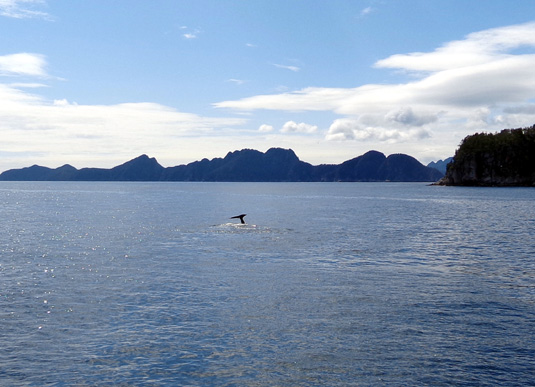
Most humpback whales spend the months of June to September feeding in
fish-rich waters in Alaska, then migrate to Hawaii to mate, give birth,
and nurture their calves until the next summer.
Like the different species of birds that feed in these waters, the
various types of whales also exhibit a kind of ecological harmony called
"niche specificity" so they aren't all competing for the same food
sources.
Gray, minke, fin, and orca whales, as well as Dall's porpoises
and Pacific white-sided dolphins, also feed in this area in the summer.
I don't believe we saw any whales today besides the humpbacks.
Continued on the
next page . . .
Happy trails,
Sue
"Runtrails & Company" - Sue Norwood, Jim O'Neil,
and Cody the ultra Lab
Previous
Next
© 2012 Sue Norwood and Jim O'Neil